As an Amazon Associate I earn from qualifying purchases.
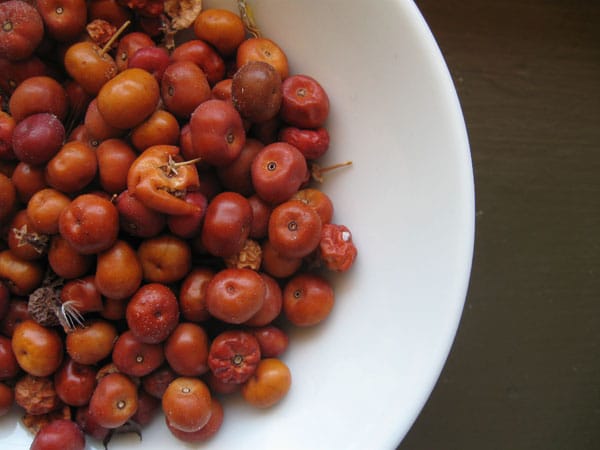
Manzanita is everywhere here in the Sierra Nevada. It is a ubiquitous shrub that can grow into a small tree, with unmistakable, gnarled branches ranging from a gaudy crimson to a muted pumpkin. Those of us in NorCal know and love this plant well. Few realize that manzanita berries are edible — and if you know what to do with them, delicious.
Some form of manzanita lives in most Western states, from British Columbia to Arizona, out to New Mexico, Nevada and Utah. There are more than 100 species of arctostaphylos, some of which, like the Presidio manzanita, which lives only in San Francisco’s Presidio, that are impossibly rare.
Manzanita leaves, which are smooth ovals, are thick, leathery and a pale gray-green, often with an even paler green underside. The shrubs are evergreen, although they will drop lots of leaves during a drought.
The plant’s flowers display its kinship with blueberries and huckleberries – they are white or pale pink urns, held in clusters of between five and 20 flowers. In California’s Central Valley, they flower as early as January, with berries coming ripe by June. Flowering comes later on the Pacific Coast and in the mountains, however.
You can eat the berries of any manzanita. Outside California, you will most likely find pinemat manzanita, A. nevadensis, A. pungens (which extends into far west Texas), greenleaf manzanita, A. patula, and hairy manzanita, A. columbiana. All are shrubs except for pinemat manzanita, which is a groundcover.
Manzanita like to live in dry, scrubby places, but there’s pretty much a species for every habitat in California. Once you learn what they look like, you will see them everywhere in the Golden State, even in parking lots. In general, however, look for manzanita in coastal scrublands, foothill chaparral, and in open, dry forests.
So, how do you eat it? You can pick the flowers, unripe berries or ripe berries.
Flowers make a lovely garnish, but you need to catch them just right: Young flowers are sweet and full of nectar, but they rapidly become tannic and bitter. The only way to tell is to taste them.
Unripe berries make a fantastic cider. Manzanita, as the Spanish speakers out there have already figured out, means “little apple” in Spanish. Green berries look a lot like tiny Granny Smith apples, and they have the same tartness. Pick them when they are still green, but have a blush of red on them. Really unripe berries are too tannic and tart to work with. You need them about halfway along. Here is my recipe for green manzanita cider.
Green berries make something very much like a dry, hard apple cider, only without the alcohol. I like this cider with a little honey on a hot day; you need to make it ahead of time by heating it gently to melt the honey. Or you can just drink it with sugar or all by itself.
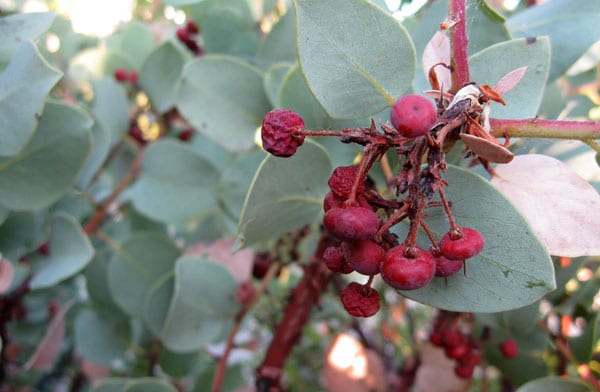
Ripe berries range from burnt umber to a deep red, and are ready anywhere from June to October depending on species and environment.
Harvesting manzanita berries is simply a matter of pulling them off the plant, but you’ll find out that many species are sticky, especially the well-named A. viscida. This means that as you harvest, you’ll pick up bits of leaf and stem that need to be winnowed out. Do this, because the twigs and leaves of manzanita are extremely tannic and will ruin your cider or your manzanita sugar, which we’ll get to in a minute.
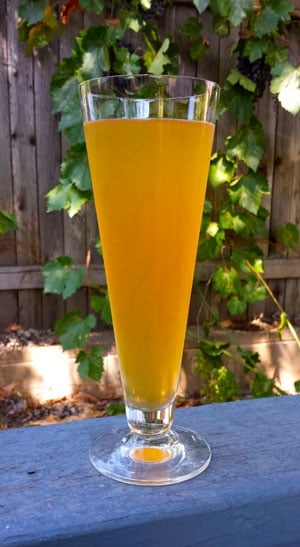
Prepping
Flowers need to be kept in a container in the fridge and used within a day or two. Unripe berries should also be kept in the fridge. They’ll hold there for a month or maybe two, but shrivel after that. You can freeze green berries, and they will keep for a year that way. Fully ripe berries are dry, so you can keep them in the pantry. They last at more than a year, although they lose sweetness over time.
Ripe berries you make into one of two things: Cider or sugar. You will need to separate the fruit from the seeds. This is easier that it might seem, because the seeds are very, very hard. All you need to do is put the ripe fruit into a spice grinder and buzz it for about 30 seconds to pulverize the soft, dry fruit and not the seeds. Then sift the ground fruit from the seeds.
You can use the ground fruit as a flour or a sugar substitute: It’s halfway between each. Manzanita “sugar” is nicely sweet and apple-like, but not so sweet you’d want to put it in your coffee.
Don’t toss the seeds. I learned this trick from fellow forager Christopher Nyerges: Boil the seeds and stray bits of fruit with water to make a sophisticated drink. Bring seeds and water to a boil, cook for 20 minutes, then let them steep until everything returns to room temperature. Then store in the fridge. If you do a ratio of 1:1 of water and seeds, you will have something like a vinegar.
If you do a 4:1 ratio of water to seeds, it will look exactly like regular apple cider, and taste similar, only with a decided tannic edge. It is a perfect starting point to make a hard manzanita cider, which we’ll get to in a moment.
You can also make a cider with the ripe manzanita berries. I like a ratio of about 1/4 cup pulverized berries to each quart of water. Boil, let it cool to room temperature and let it steep overnight. This ripe manzanita berry cider is pleasant but mild – a little like Gatorade – and needs no additional sugar.
Once made, you can make syrup out of this cider and from there make ice cream or sorbet, or use it as a concentrate for a cooling drink or a manzanita martini. Go 1:1 in volume with sugar and cider.
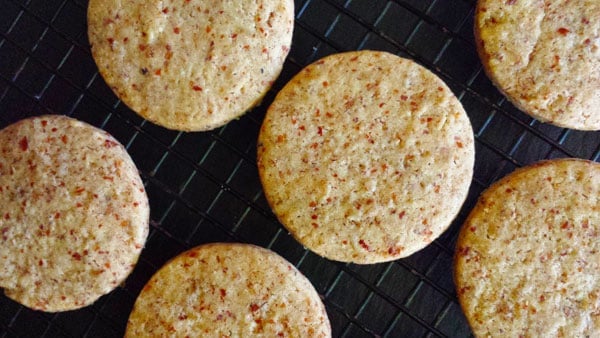
You can dilute this syrup to about 22 brix (specific gravity of 1.092) and ferment it into wine. Once you have your wine, use it as a base to mix with seltzer water and you have a damn good hard manzanita cider. This is what I do with most of my unripe berries.
The ripe manzanita berries really shine in baked goods. Think muffins, cookies, dessert and breakfast breads. If you’re into powders on your foods, manzanita sugar is a fun thing to sprinkle over ice cream or on a composed dessert. Mostly I make these manzanita shortbread cookies, which are pretty excellent, if I do say so myself.
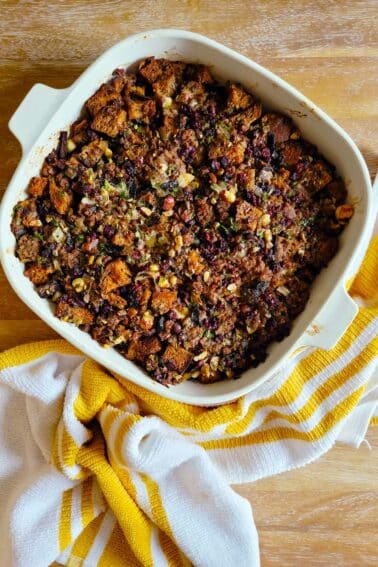
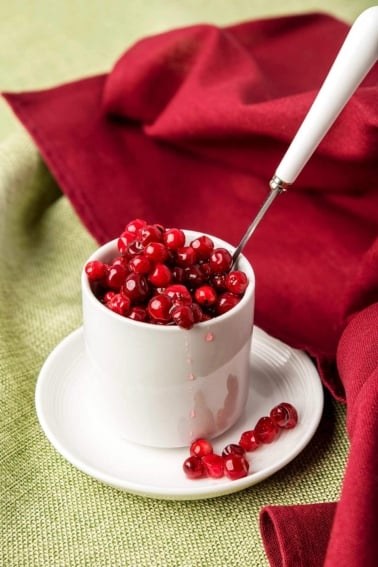


I’ve used your instructions to make cider and sugar in a couple different iterations over the years. The variety in flavor depending on species is just incredible.
For example, when living in Trinity County, CA, I had abundant A. patula available to harvest. The berries were sweet enough that the cider needed no extra sugar or honey. It was sweet on its own. As was the sugar.
Now, living in Southern Oregon, I harvest berries from A. columbiana and A. viscida. They yield a much more sour product that has to be used differently than A. patula sugar. I look forward to experimenting with more species. I prefer A. patula products at this point.
God damn mother fucking badass! Everytime I look up some wild food recipe I end up here! Thank you good sir. ?
A lot of great ideas. Thank you for spreading the knowledge!
Where I live we have the Archtostaphylos osoensis, an endemic to the San Luis Obispo area.
Do you have a recipe for the manzanita shortbread cookies that you would be willing to share? My children love picking the flowers on pur hikes and would be thrilled to make cookies with the fruit.
Greatly appreciated!
I have lots of Manzanita and never knew they could be eaten. I know the bears eat them. May I please have the link or recipe for manzanita shortbread cookies?
TK
I’d love to have the link or recipe for manzanita shortbread cookies. I just started following you on FB.
Hi TK, I too have many manzanita trees on my ranch in Southern California. It’s February and are blossoming. Can’t wait to try the berries. Zena
I make a tea with the late harvest berries and it’s very pleasant.
Where can a person purchase this? We live in Florida so no local source I can find.
Eddie: You can’t. Sorry.
I am going to make manzanita mead. Does anyone know of a source for manzanita honey? I want about 20 lbs.
Hank: really? Now I have even more reasons to get down to Bryce soon…
This made me homesick and sad. I’ve scratched myself on manzanita bushes hiking in Northern California more times than I can count, and I never knew they were edible at all! And ‘cider with a tannic edge’ sounds just about perfect. Alas, if there are manzanitas in Utah I have yet to find them.
Becca: Ask and ye shall receive. Look for greenleaf manzanita, Arctostaphylos patula, in Bryce National Park.
I have often, while out of hikes, taken small handfulls of dry manzanita berries and put them in my mouth and crushed them against the top of my mouth moistened the mixture and extracted a nice bit of thirst quenching apple like liquid and then spit out the hard parts. Glad to learn about the technique for making a more usable product.
Lately I have been making infusion liqueurs with vodka, soaking various herbs or fruits and then added sugar syrup. Made a very nice one with manzanita’s big brother- madrone. Used both the ripe berries and some of the thin papery bark peelings. Well worth trying. Much better than the Nocino I made from green walnuts. I suspect the manzanita berries would be good for this as well.
I recently discovered manzanita berries while I was foraging for ingredients for an Edible Desert Dinner I was curating in Superior, AZ. I have about 3lbs. of hand milled “flour” but neglected to save some dried berries. The season is over so I’m looking for a supplier if you know of any.
My grandma always made manzanita jelly. How do you process the berries for that?
I love manzanita bushes; they’re beautiful and they have so much character. I grew up eating the flowers off the bushes around my house.
Great post love all of the info. I live in northern California. So this is awesome
Hank, I wish we had manzanita in central TX. The cider sounds delicious. Just wanted to say you have a truly wonderful website/blog, one of my all time favorites!!! Right up there with wedlinydomowe! Thanks for all you do. What we do have here is lots of wild hogs and deer and I’m already licking my lips thinking about jerky and sasauge. Gimme a shout if you’re ever around Austin, always got some in the freezer to share. Ciao!
great post- perfect timing too- I’m about an hour east of you! thanks again!
this is EXACTLY the info i am looking for right this minute!
thank you so much!!
–i have wondered about these berries, and had thought they might be edible, since a close relative the ‘strawberry tree’ also has edible fruit that i quite like—many people /writers don’t seem to, for whatever reason, but truly, the strawberry tree fruit HAS a nice taste. i am thinking there are probably some GREAT nutrients in manzanita berries as well..
anyway, thank you so much for this-
can i eat the dry manzanita out-of-hand like raisins? (watching out for the seeds i guess)?
Johanna: Yes… sort of. They are very dry. When I am in a charitable mood, I like to think of them like Pixie stix, but yes, the seeds are like rocks.
I had NO idea manzanita trees had edible berries.
And, that shortbread looks outrageous. I’m going to
go look for the trees tonight as soon as I get out of
my cube!
great post and beautiful photos – makes me a little sad that mazanitas don’t grow around here (i’m in New England).
Wow! Such a detailed and informative blog post, and about a Genus I’m not familiar with (being based in the UK). Thanks for sharing 🙂